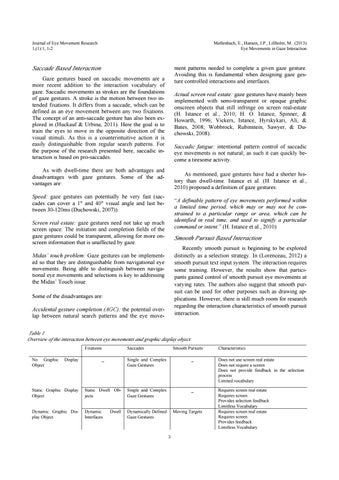Journal of Eye Movement Research 1,(1):1, 1-2
Møllenbach, E., Hansen, J.P., Lillholm, M.. (2013) Eye Movements in Gaze Interaction
Saccade Based Interaction
ment patterns needed to complete a given gaze gesture. Avoiding this is fundamental when designing gaze gesture controlled interactions and interfaces.
Gaze gestures based on saccadic movements are a more recent addition to the interaction vocabulary of gaze. Saccadic movements as strokes are the foundations of gaze gestures. A stroke is the motion between two intended fixations. It differs from a saccade, which can be defined as an eye movement between any two fixations. The concept of an anti-saccade gesture has also been explored in (Huckauf & Urbina, 2011). Here the goal is to train the eyes to move in the opposite direction of the visual stimuli. As this is a counterintuitive action it is easily distinguishable from regular search patterns. For the purpose of the research presented here, saccadic interaction is based on pro-saccades.
Actual screen real estate: gaze gestures have mainly been implemented with semi-transparent or opaque graphic onscreen objects that still infringe on screen real-estate (H. Istance et al., 2010; H. O. Istance, Spinner, & Howarth, 1996; Vickers, Istance, Hyrskykari, Ali, & Bates, 2008; Wobbrock, Rubinstein, Sawyer, & Duchowski, 2008). Saccadic fatigue: intentional pattern control of saccadic eye movements is not natural; as such it can quickly become a tiresome activity.
As with dwell-time there are both advantages and disadvantages with gaze gestures. Some of the advantages are:
As mentioned, gaze gestures have had a shorter history than dwell-time. Istance et al. (H. Istance et al., 2010) proposed a definition of gaze gestures:
Speed: gaze gestures can potentially be very fast (saccades can cover a 1° and 40° visual angle and last between 30-120ms (Duchowski, 2007)).
“A definable pattern of eye movements performed within a limited time period, which may or may not be constrained to a particular range or area, which can be identified in real time, and used to signify a particular command or intent.” (H. Istance et al., 2010)
Screen real estate: gaze gestures need not take up much screen space. The initiation and completion fields of the gaze gestures could be transparent, allowing for more onscreen information that is unaffected by gaze.
Smooth Pursuit Based Interaction Recently smooth pursuit is beginning to be explored distinctly as a selection strategy. In (Lorenceau, 2012) a smooth pursuit text input system. The interaction requires some training. However, the results show that participants gained control of smooth pursuit eye movements at varying rates. The authors also suggest that smooth pursuit can be used for other purposes such as drawing applications. However, there is still much room for research regarding the interaction characteristics of smooth pursuit interaction.
Midas’ touch problem: Gaze gestures can be implemented so that they are distinguishable from navigational eye movements. Being able to distinguish between navigational eye movements and selections is key to addressing the Midas’ Touch issue. Some of the disadvantages are: Accidental gesture completion (AGC): the potential overlap between natural search patterns and the eye move-
Table 1 Overview of the interaction between eye movements and graphic display object. Fixations
Saccades
Smooth Pursuits
Characteristics
_
Single and Complex Gaze Gestures
_
Does not use screen real estate Does not require a screen Does not provide feedback in the selection process Limited vocabulary
Static Graphic Display Object
Static Dwell Objects
Single and Complex Gaze Gestures
_
Dynamic Graphic Display Object
Dynamic Interfaces
Dynamically Defined Gaze Gestures
Requires screen real estate Requires screen Provides selection feedback Limitless Vocabulary Requires screen real estate Requires screen Provides feedback Limitless Vocabulary
No Graphic Object
Display
Dwell
Moving Targets
3

